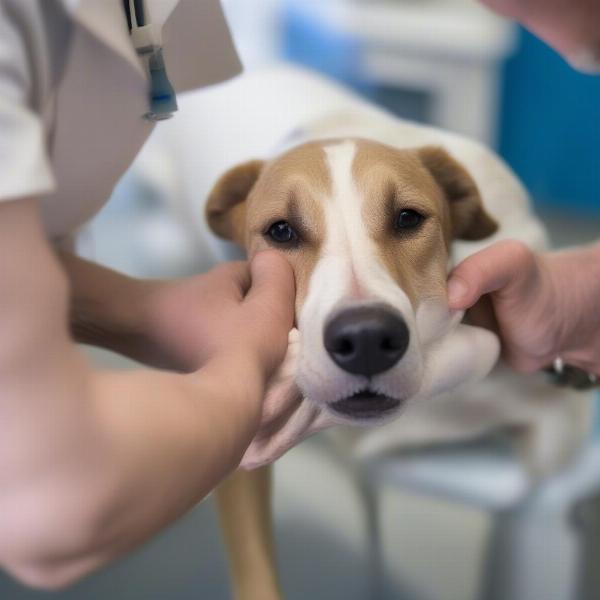Dog knee replacement surgery, or canine total knee arthroplasty (TKA), is a significant procedure offering pain relief and improved mobility for dogs suffering from severe knee joint disease. This guide delves into the procedure, recovery process, and factors to consider when contemplating this option for your furry friend.
Choosing dog knee replacement is a big decision, and understanding the intricacies of the procedure is crucial. Conditions like osteoarthritis and cruciate ligament ruptures can significantly impact a dog’s quality of life, causing pain, lameness, and reduced activity. While conservative treatments like medication and physical therapy can help manage these conditions in their early stages, severe cases often require surgical intervention. Knee replacement offers a long-term solution for restoring mobility and relieving pain in these situations. The procedure involves replacing the damaged joint surfaces with metal and plastic implants, mimicking the natural function of the knee.
Understanding the Need for Dog Knee Replacement
When conservative treatments fail to alleviate pain and restore mobility, knee replacement becomes a viable option. This procedure is typically recommended for dogs with severe osteoarthritis, irreparable cruciate ligament injuries, or other conditions causing chronic knee pain and dysfunction. Understanding the underlying cause of your dog’s knee problems is essential in determining if knee replacement is the right course of action.
Diagnosing Knee Issues in Dogs
Veterinarians employ various diagnostic tools to assess the extent of knee damage. X-rays reveal the condition of the bones and joint space, while other imaging techniques like MRI and CT scans provide a more detailed view of the surrounding soft tissues. A thorough physical examination, including assessing the dog’s gait and range of motion, also plays a vital role in diagnosis.
 Dog's leg being examined by a vet
Dog's leg being examined by a vet
The Dog Knee Replacement Procedure
The dog knee replacement procedure is similar to human knee replacement. It involves removing the damaged cartilage and bone from the femur and tibia and replacing them with metal implants. A plastic spacer is inserted between the metal components to facilitate smooth joint movement.
Post-Operative Care and Recovery
Post-operative care is crucial for successful recovery. Pain management is paramount, and your veterinarian will prescribe appropriate medications to keep your dog comfortable. Physical therapy, including controlled exercises and range of motion activities, is essential for regaining strength and mobility.
Factors to Consider Before Dog Knee Replacement
Several factors influence the suitability of knee replacement. The dog’s age, overall health, and the severity of the knee condition are key considerations. Your veterinarian will assess these factors to determine if your dog is a good candidate for the procedure. The cost of the surgery and the commitment to post-operative care are also important factors to consider.
Long-Term Prognosis and Outcome
With proper post-operative care and rehabilitation, most dogs experience significant improvement in their mobility and pain levels after knee replacement. They can resume many of their normal activities, enjoying a better quality of life. However, regular check-ups and ongoing management are essential to ensure the long-term success of the procedure.
Is Dog Knee Replacement Right For My Dog?
Considering dog knee replacement? Discuss these questions with your veterinarian:
- What is the underlying cause of my dog’s knee problem?
- What are the alternative treatment options?
- What are the risks and benefits of knee replacement surgery?
- What is the expected recovery time?
- What is the long-term prognosis?
Conclusion
Dog knee replacement offers a promising solution for dogs suffering from debilitating knee conditions. It’s a significant decision that requires careful consideration and consultation with your veterinarian. By understanding the procedure, recovery process, and factors involved, you can make an informed choice that prioritizes your dog’s well-being.
FAQ
-
How long does a dog knee replacement last? With proper care, a dog knee replacement can last for many years, often for the remainder of the dog’s life.
-
How much does dog knee replacement cost? The cost can vary depending on location and the specific needs of the dog, but it’s typically a significant investment.
-
What are the alternatives to dog knee replacement? Alternatives include conservative management with medication and physical therapy, other surgical procedures like TPLO, or, in severe cases, amputation.
-
Is dog knee replacement painful? While the surgery itself is performed under anesthesia, post-operative pain management is crucial, and your vet will provide appropriate pain relief.
-
How long is the recovery period after dog knee replacement? Recovery typically takes several months, involving restricted activity, physical therapy, and regular veterinary check-ups.
-
Can all dogs have knee replacement surgery? Not all dogs are suitable candidates. Factors like age, overall health, and the severity of the knee condition are considered.
-
What are the signs that my dog might need knee replacement surgery? Signs include chronic lameness, difficulty walking or standing, pain, and decreased activity levels despite conservative treatments.
ILM Dog is your trusted resource for expert advice on dog care, health, training, and more. We offer a wealth of information to help you make informed decisions about your canine companion. From breed selection to senior care, we cover all aspects of dog ownership. Whether you’re a new dog owner or a seasoned expert, ILM Dog has the resources you need. Contact us today for personalized guidance. Email: [email protected], Phone: +44 20-3965-8624. ILM Dog is dedicated to providing you with the latest information on dog health, including knee replacement.